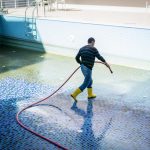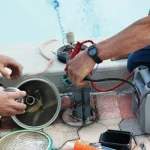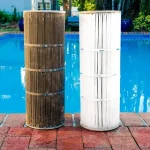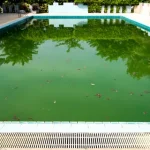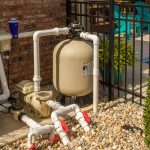The Ultimate Guide to Pool Opening and Closing
Your Comprehensive Checklist for a Sparkling Clean Pool
As a pool owner, ensuring your pool is in top condition for the summer season and properly closed for the winter is crucial. Not only does it extend the life of your pool, but it also provides a safe and enjoyable swimming environment. This guide offers a detailed checklist for both opening and closing your pool, ensuring you cover every essential step for a hassle-free pool season.
Pool Opening Checklist
Welcome the Warm Weather with a Sparkling Pool
Remove, Clean, and Store the Pool Cover: The first step in opening your pool is to remove, clean, and store the pool cover. Carefully remove the cover, ensuring that no debris falls into the pool. Lay it out on a clean surface and rinse thoroughly with a garden hose. Once it’s clean, allow it to dry completely before folding and storing it in a dry, cool place to prevent mildew and damage.
Inspect and Reconnect Pool Equipment: Next, inspect and reconnect all pool equipment that was disconnected during the winter, including pumps, filters, heaters, and chlorinators. Check for any visible damage or wear and replace any parts as needed. Removing winterizing plugs and accessories is also crucial; replace them with regular drain plugs and skimmer baskets.
Fill the Pool to the Proper Level: Fill your pool to the proper level using a garden hose, ensuring it reaches the midway point of the skimmer opening or the specified level for your pool type. While the pool is filling, inspect the pool structure and liner for any signs of damage or wear.
Clean the Pool: Cleaning the pool is essential to start the season right. Use a leaf net or skimmer to remove any debris from the pool surface. Brush the pool walls and floor to loosen dirt and algae, then vacuum thoroughly. This ensures your pool is clean and ready for use.
Check and Balance the Water Chemistry: Check and balance the water chemistry by testing the pool water with a reliable test kit. Ensure the pH, alkalinity, calcium hardness, and chlorine levels are within the ideal range: pH (7.4-7.6), Alkalinity (80-120 ppm), Calcium Hardness (200-400 ppm), and Chlorine (1-3 ppm). Adjust the chemical levels as necessary to achieve balanced water chemistry.
Shock the Pool: Shocking the pool is the next step. Add a pool shock product to the water to eliminate any remaining bacteria and contaminants. Run the pool pump and filter continuously for at least 24 hours to circulate the shock treatment effectively.
Run and Inspect the Filtration System: Finally, run and inspect the filtration system. Turn on the system and let it run continuously for 24-48 hours. During this time, check for any leaks, unusual noises, or malfunctions, and address any issues promptly to ensure your pool operates smoothly throughout the season.
Pool Closing Checklist
Clean the Pool Thoroughly: Begin the pool closing process by cleaning the pool thoroughly. Remove all debris using a skimmer net and brush the walls and floor to loosen any dirt. Vacuum the pool to ensure it’s completely clean, providing a good start for the next season.
Test and Balance the Water Chemistry: Testing and balancing the water chemistry is crucial before closing the pool. Use a test kit to check pH, alkalinity, calcium hardness, and chlorine levels, and adjust as necessary to prevent corrosion, scaling, and algae growth over the winter. Aim for the same chemical levels as in the opening checklist.
Lower the Water Level: Lower the water level to below the skimmer and return lines to prevent freezing damage. Follow manufacturer guidelines if you have a vinyl-lined pool to avoid liner damage. This step is essential to protect your pool’s structural integrity during the winter months.
Drain and Winterize Pool Equipment: Drain all pool equipment, including pumps, filters, heaters, and chlorinators. Store removable parts indoors and add non-toxic antifreeze to plumbing lines if necessary to prevent any water left inside from freezing and causing damage.
Add Winterizing Chemicals: Add winterizing chemicals to the pool, including algaecide, chlorine shock, and a stain and scale preventer. Circulate the chemicals through the pool by running the pump for a few hours before shutting it down. This ensures the chemicals are evenly distributed and effective throughout the winter.
Install Winterizing Plugs and Accessories: Install winterizing plugs in the skimmer and return lines to prevent water from entering and freezing. Place ice compensators in the skimmer to absorb the expansion of freezing water. These steps help protect your pool’s plumbing and equipment from freezing damage.
Cover the Pool: Finally, cover the pool with a winter pool cover, ensuring it is secure and free of gaps. Use water bags, cover clips, or other securing devices to keep the cover in place, protecting the pool from debris and harsh weather. A properly secured cover is essential for maintaining the cleanliness and safety of your pool over the winter months.
Conclusion
Properly opening and closing your pool is essential for maintaining its condition and ensuring a safe and enjoyable swimming experience. By following this comprehensive checklist, you can protect your investment and extend the life of your pool. At Pool Responders, we’re here to assist you with all your pool care needs, from routine maintenance to emergency repairs. Contact us today for professional, reliable pool services that will keep your pool in pristine condition year-round.


